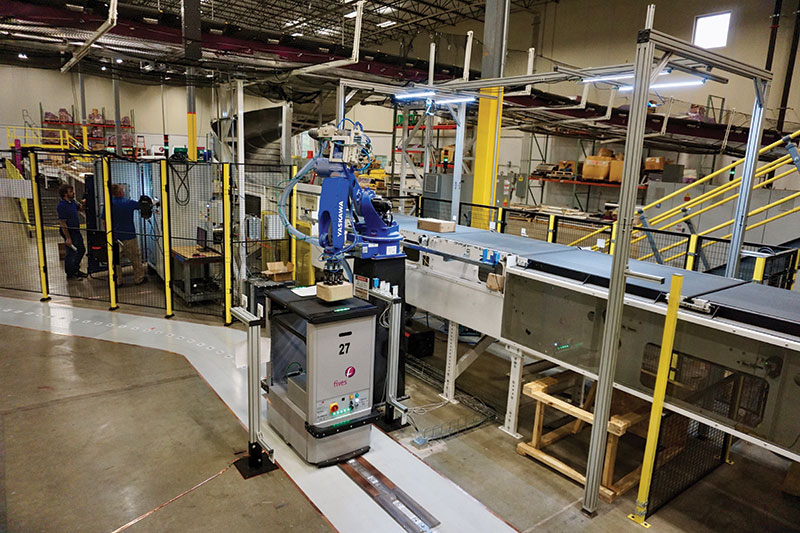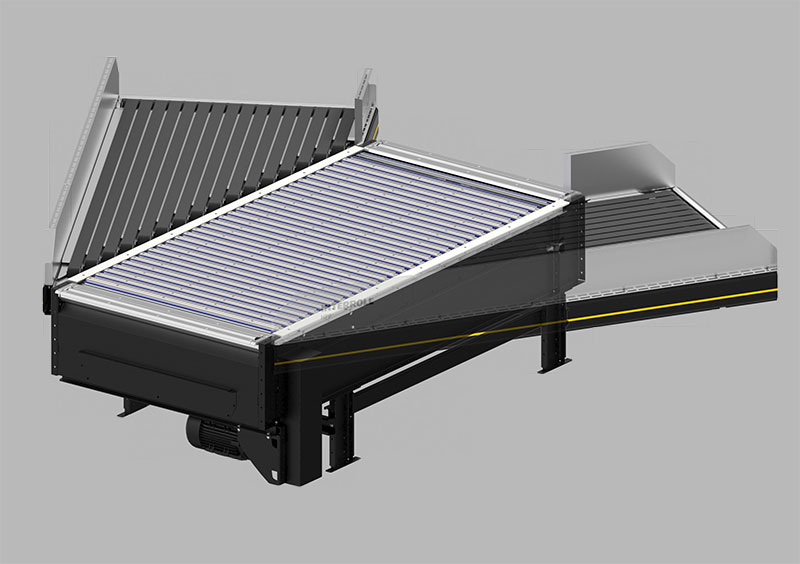值得关注的6个传送带及分拣发展趋势
在自动化时代,仓库传送带和分拣系统正在不断演进。
By Bridget McCrea February 3, 2025
**电子商务的持续需求、劳动力短缺以及“以少做多”的需求,正推动仓库运营商寻找新的方式来优化效率并降低成本。
作为典型履行操作的核心设备,传送带和分拣设备正在演变为动态、智能的系统,这得益于更多自动化、机器人技术和自主技术的引入。与此同时,人工智能(AI)正在进入一系列系统,分析大量数据、预测瓶颈并支持仓库现场的实时、主动决策。显然,随着仓库的不断发展,支持它们的系统也必须能够扩展、适应和增长。
以下是2025年使用或计划投资传送带和分拣系统的公司应关注的六大趋势:
### 1. **让自主移动机器人(AMR)与传送带协同工作**
部署新系统是一回事,但让这些解决方案协同工作、协调并共享数据则完全是另一回事。
Hytrol的首席营收官Mitch Smith表示:“关键在于将传送带、AMR、货到人系统和/或自动化存储与检索系统(AS/RS)结合起来,使它们和谐运作。”他注意到目前这一目标正受到更多重视。
Interroll USA的分拣解决方案销售总监Martin Clark表示,市场上AMR的数量激增,同时关节臂机器人的商品化程度也在提高。十年前,末端工具定义了功能,而机械臂则成为商品,但现在情况发生了变化。
Clark说:“因此,我们看到AMR本身正在迅速商品化,因此我们专注于用于产品转移的AMR传送带顶部,以及开发智能且安全的传送带产品线,以与AMR制造商对接。”
### 2. **利用人工智能**
Smith表示,Hytrol正在设备设计阶段更多地使用AI,以帮助匹配特定客户的解决方案,并开发可直接用于生产的图纸、物料清单和采购流程。
“这有助于我们缩短交付周期,”Smith说。
FORTNA的集成产品开发高级总监Bill Atherton表示,该公司正在使用AI来协调传送带上的产品,以最大限度地利用货到人系统和处理站。
Atherton说:“算法可以从存储中‘预拣’箱子,并使用运输传送带作为实时缓冲区,而不会溢出,因为我们知道一切的处理速度。”FORTNA的产品开发团队还在构思一种支持AI的系统,以提供对传送带上物理流动货物的更好可见性。
TREW Automation的产品经理Drew Herchenbach表示:“现在每个人都在将AI术语融入他们的产品中。”TREW在其分拣技术中使用AI,帮助用户主动维护设备并减少停机时间。
Herchenbach解释说:“我们的分拣机像汽车的检查引擎灯或低胎压灯一样提醒用户。它会在引擎或轮胎变成更大问题之前告诉你存在问题。”
### 3. **管理更多种类的包裹和包装**
产品多样化和个性化需求对仓库及其设备提出了重大挑战。复杂性的增加推动了对更复杂物料处理解决方案的需求,以高效处理各种尺寸、形状和重量的包裹。例如,在包裹领域,Hytrol的包裹业务发展总监Trav Tacker表示,小件物品越来越小,而大件物品则越来越大。
“这听起来可能有点反直觉,”Tacker说,“但设施正被更大、笨重的物品淹没,同时还需要处理更多的小订单。”
传统上,较大的物品被装载到手推车上,并由牵引车在设施内运输。“这非常低效,甚至可能带来安全隐患,”Tacker说。较小的产品也带来了自己的挑战。例如,塑料袋和其他难以传送的物品(如装在塑料袋中的瓶装药品)可能会在过渡区域卡住。
Tacker表示,AMR可以帮助解决这些问题,尤其是在从“分拣输入侧”卸载卡车和拖车时。这些车辆也可以在另一端或“分拣后”过程中提供帮助。  Fives Intralogistics Corp.的销售副总裁Scott Reid也注意到包裹领域中包装和产品的多样性,AGV、机械臂和其他先进选项在将包裹高效引导至指定目的地方面发挥着越来越重要的作用。
Fives Intralogistics Corp.的销售副总裁Scott Reid也注意到包裹领域中包装和产品的多样性,AGV、机械臂和其他先进选项在将包裹高效引导至指定目的地方面发挥着越来越重要的作用。
Reid说:“随着电子商务的持续增长和繁荣,我们看到对包裹的需求在两端都大幅增加——从非常大的商品到非常小的饰品,以及介于两者之间的一切。传统传送带设备有时可能难以应对这种范围更广的小包裹和大包裹。公司希望专门针对分拣领域的解决方案,并帮助自动化这些传统上手动处理的流程。”
### 4. **解决噪音问题**
大型设备会产生噪音,传送带和分拣设备也不例外。电机的持续嗡嗡声、包裹的碰撞声以及金属摩擦的刺耳声可能对员工的身心健康和运营效率造成影响。
意识到这一点,Interroll和TREW等制造商正在努力减少噪音,帮助客户创造更轻松的工作环境。
Clark说:“噪音减少仍然是分拣系统中的一个挑战。”他补充说,公司不再选择每分钟650英尺(FPM)或更高速率的单一锯齿合并,而是选择多个每分钟300至350 FPM的低速合并。
“这减少了噪音,并提供了额外的好处,因为你不再有单点故障,”Clark补充道。他表示,通过从使用动力合并和分流的塑料托盘转向全皮带或条带皮带动力分流,也可以实现噪音减少。
Herchenbach表示,传送带和分拣领域的噪音减少是一个持续改进的过程,而不是“设置后就不管”的任务。为了最大限度地减少噪音排放,TREW将单个分拣机和端到端系统纳入考虑。它还开发了带有电机驱动滚筒(MDR)的模块化传送带系统,使用小型直流电机驱动运输滚筒。
“这些系统既更安静又更节能,”Herchenbach说,他指出公司使用复杂的工具、分析和设计变更来解决高容量系统产生的噪音。“噪音减少涉及很多科学。”
### 5. **寻求部署时间更短的解决方案**
公司也在更多地使用模块化传送带和分拣系统——Reid在过去一年左右看到了更多这种趋势。简而言之,公司希望能够尽快部署系统并获得容量。而可扩展的模块化系统可能有助于实现这些目标。
Reid说:“公司仍然对大型分拣系统感兴趣,他们提前几个月甚至几年规划容量,但我们也开始看到向更多‘灵活容量’的转变。”他将此描述为能够快速增加一个地点的容量,以帮助缓解年中出现的一些问题。
AMR在这里发挥了作用。Reid说:“AMR是可快速部署的解决方案,是一种可以从一个设施转移到另一个设施的技术,影响最小,且不需要在地板上钻孔或经历漫长、劳动密集的安装过程。这是我们在过去6到12个月中看到的一个趋势,并预计会持续下去。”  ### 6. **为现代问题开发新解决方案**
### 6. **为现代问题开发新解决方案**
专注于持续改进,传送带和分拣设备制造商、软件开发人员和实施合作伙伴正在密切关注不断变化的履行环境。他们利用客户反馈和市场洞察来调整现有解决方案并开发新解决方案以应对现代问题。
例如,在FORTNA,Atherton表示,公司帮助客户尽量减少可能导致流程不平衡的缓冲区。他补充说,这些不平衡可能代价高昂,但仓库执行系统(WES)可以帮助减少这些不平衡及相关成本。
Atherton说,在分拣机方面,公司通常会在分拣后的导入和处理过程中面临“需要大量劳动力”的挑战。
鉴于大多数仓库和DC都在应对劳动力限制,他表示FORTNA一直在开发新解决方案来解决这个问题,像AutoStore网格、机器人穿梭车和AMR这样的异步货到人交付系统都可以帮助“克服传送带系统的线性限制”。
The relentless demands of e-commerce, persistent labor constraints and the need to “do more with less” are all driving warehouse operators to find new ways to optimize efficiency and minimize costs.
Mainstays of the typical fulfillment operation, conveyors and sortation equipment are evolving into dynamic, intelligent systems thanks to the introduction of more automation, robotics and autonomous technologies.
At the same time, artificial intelligence (AI) is making its way into a range of systems, analyzing vast volumes of data, predicting bottlenecks and supporting real-time, proactive decision-making on the warehouse floor. It’s clear that as warehouses continue to evolve, the systems that support them will also have to be able to grow, scale and adapt.
Here’s a look at the six top trends companies who are using or planning to invest in conveyor and sortation systems in 2025 should be tracking:
1.Get autonomous mobile robots (AMRs) and conveyors working together.
Putting new systems in place is one thing, but getting those solutions to work together, coordinate and share data is a completely different beast.
“The key is marrying the conveyor, AMR, goods-to-person and/or automated storage and retrieval system (AS/RS) so they work in harmony,” says Hytrol’s chief revenue officer Mitch Smith, who is seeing more emphasis on this goal right now.
Martin Clark, sorter solutions sales director at Interroll USA, says there’s been a proliferation of AMRs in the marketplace along with the increased commoditization of articulating arm robots. Ten years ago, end-of-arm tools defined the functionality and the arm became a commodity, he says. That’s since changed.
“To this end, we now see AMRs themselves being rapidly commoditized, so we’re focusing on the AMR conveyor tops used in product transfer,” says Clark, “as well as the development of a smart and safe conveyor product line to interface with AMR manufacturers.
2. Leverage artificial intelligence.
Smith says Hytrol is using more AI in the equipment design phase to help match solutions to specific customers and develop shop-ready drawings, bills of materials and procurement processes.
“This helps us shorten lead times,” says Smith.
At FORTNA, Bill Atherton, senior director of integrated product development, says the company is using AI to orchestrate product on conveyors to get maximum utilization of both goods-to-person systems and processing stations.
“The algorithms can ‘pre-pick’ the bins from storage and use the transportation conveyor as a real-time buffer that won’t overflow,” says Atherton, “because we know how fast everything is being processed.” The FORTNA product development team is also conceptualizing an AI-enabled system that provides improved visibility over goods that are physically flowing on the conveyor at any given point.
“Everyone is incorporating AI verbiage into their product offerings right now,” says Drew Herchenbach, product manager at TREW Automation, which is using AI in its sortation technology to help users proactively maintain their equipment and reduce downtime.
“Our sorters inform users much like a check engine or a low tire pressure [light] works in a car,” Herchenbach explains. “It tells you there’s an issue before that engine or tire becomes an even bigger issue.”
3. Manage a wider variety of parcels and packages.
Demand for product diversity and personalization presents a significant challenge for warehouses and the equipment that runs them. The increased complexity is driving up demand for more sophisticated materials handling solutions to efficiently process a diverse range of package sizes, shapes and weights. In the parcel space, for example, Trav Tacker, director of parcel business development at Hytrol, says small items are getting smaller and big items are growing even larger.
“This may sound a little counterintuitive,” says Tacker, “but facilities are being inundated by larger, big-and-bulky items and at the same time are having to handle a higher volume of very small orders.”
Traditionally, the larger items were loaded onto carts and driven around facilities by tugger carts. “This is very inefficient and can even be a safety hazard,” says Tacker. Smaller products pose their own set of challenges. For example, poly bags and other difficult-to-convey items (for example, bottled pharmaceutical products placed in polybags) can get hung up in transition areas.
Tacker says AMRs can help resolve these issues particularly when it comes to unloading trucks and trailers from the “input side of sortation.” The vehicles can also help on the other end, or during the “after sort” process.

Scott Reid, vice president of sales Fives Intralogistics Corp., is also seeing more packaging and product variation in the parcel space, where AGVs, robotic arms and other advanced options are playing an increasingly important role in efficiently directing packages to their designated destinations.
“As e-commerce continues to grow and boom, we’re seeing a lot more requirements for packages on both ends of the spectrum—from really large merchandise right down to very small trinkets, and everything in between,” Reid says. “Traditional conveyor equipment may at times struggle with that [broadening] range of smaller and larger packages. Companies want solutions specifically [targeted] to the sorting arena, and that can help automate those processes, most of which have traditionally been handled manually.”
4.Tame the noise problem.
Big pieces of equipment generate noise, and conveyors and sortation equipment are no exception. The constant whirring of motors, clattering of packages and screech of metal-on-metal can take a toll on both employee wellbeing and operational efficiency.
Knowing this, manufacturers like Interroll and TREW are working to quell the din and help their customers create more stress-free work environments.
“Noise reduction remains a challenge in sortation systems,” says Clark, who adds that instead of a single sawtooth merge with high-speed induction rates of 650 feet per minute (FPM) or higher, companies are opting for multiple lower speed inductions of 300 to 350 FPM.
“This reduces noise, and provides an additional benefit as you no longer have a single point of failure,” Clark adds. He says noise reduction is also being achieved by moving away from plastic totes transported by powered merges and diverges to full belt or strip belt-powered diverges.
Herchenbach says noise reduction on the conveyor and sortation front is all about continuous improvement, and that it’s not a “set it and forget it” exercise. To minimize noise emissions, TREW factors any individual sorters and end-to-end systems into the equation. It has also developed modular conveyor systems with motor-driven live rollers (MDRs) that use small DC motors to drive the transportation rollers.
“These are both quieter and more energy efficient,” says Herchenbach, who notes that the company uses sophisticated tools, analysis and design changes to address noise generated by higher-capacity systems. “There’s a lot of science involved with noise reduction.”
5. Seek solutions with shorter deployment times.
Companies are also using more modular conveyor and sortation systems—a trend Reid has seen more of over the last year or so. Put simply, companies want to be able to deploy systems and gain capacity as quickly as possible. And scalable, modular systems may help them hit those goals.
“Companies are still interested in the larger sortation systems, where they’re planning their capacities months or even years in advance, but we’ve also started to see a shift toward more ‘flex capacity,’” says Reid, who describes this as being able to quickly increase capacity at one location to help mitigate some of the issues that arise midyear.
AMRs come into the picture here. “AMRs are quickly deployable solutions and a piece of technology that can be picked up from one facility and moved to another one with minimal impact and no drilling into the floors or enduring a lengthy, labor-intensive installation process,” says Reid. “This is a trend we’ve seen more of over the last six to 12 months and that we expect to continue.”

6. Develop new solutions to modern problems.
Focused on continuous improvement, conveyor and sortation equipment makers, software developers and implementation partners are keeping a finger on the pulse of the changing fulfillment landscape. They’re using customer feedback and market insights to tweak existing and develop new solutions to modern problems.
At FORTNA, for example, Atherton says the company helps its customers minimize any buffers that may lead to imbalanced processes. Those imbalances can be expensive, he adds, but a warehouse execution system (WES) can help minimize those imbalances and the associated costs.
With sorters, Atherton says companies will often face challenges at induction and processing post-sort that “require quite a bit of labor.”
Knowing that most warehouses and DCs are dealing with labor constraints, he says FORTNA has been developing new solutions to that problem, and that asynchronous goods-to-person delivery systems like AutoStore grids, robotic shuttles and AMRs can all help “overcome the linear restrictions of conveyor systems.”

全部 0条评论